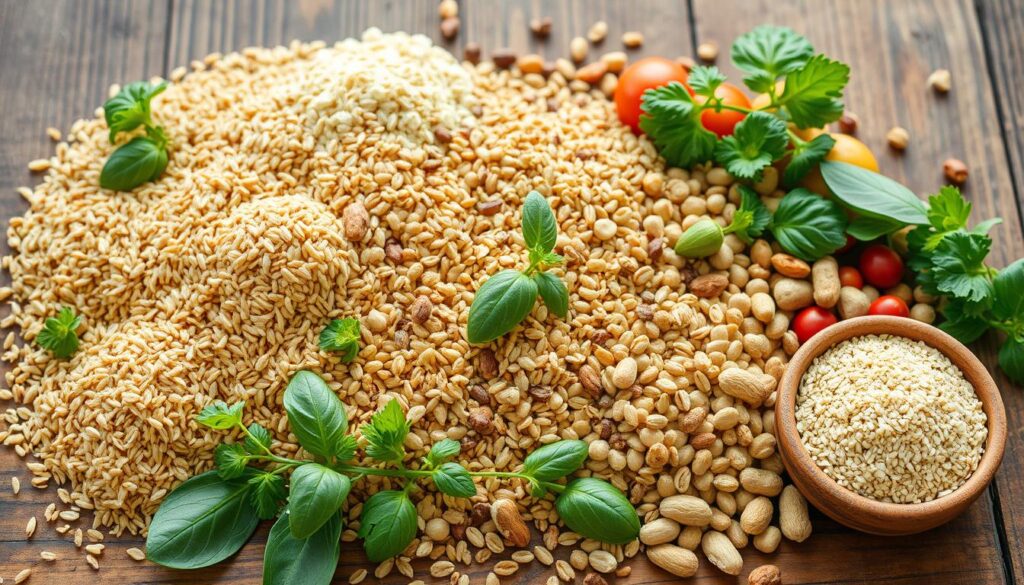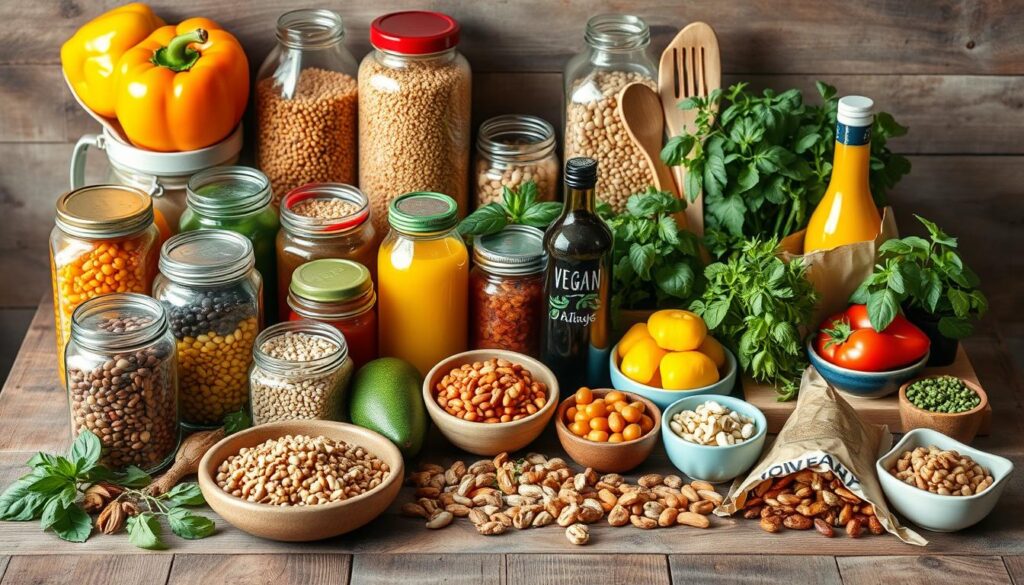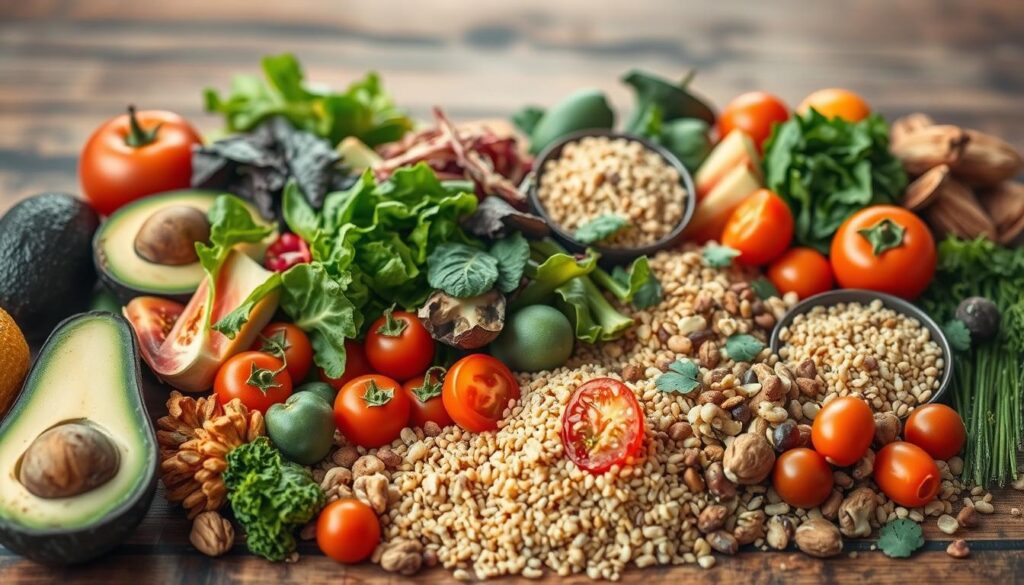Choosing a vegan lifestyle means no animal products in your food. This choice is good for your health and the planet. You can get all the nutrients you need from plants like grains, fruits, and nuts.
This guide is for anyone starting or growing their vegan journey. It covers everything from what veganism is to how to eat well. You’ll learn to make choices that are good for you and the planet.
Key Takeaways:
- Veganism eliminates all animal-derived products, including meat, dairy, eggs, and honey.
- A well-planned vegan diet can provide a wide range of essential nutrients and health benefits.
- Incorporating a variety of plant-based whole foods is key to a balanced and satisfying vegan lifestyle.
- Understanding the differences between plant-based and vegan diets can help you make informed choices.
- Vegan diets can have a positive impact on the environment and align with ethical beliefs.
Understanding Plant-Based vs. Vegan Diets
“Plant-based” and “vegan” diets are often mixed up, but they’re not the same. A plant-based diet is mostly plants like fruits, veggies, and grains. A vegan diet doesn’t include any animal products like meat or dairy.
Key Differences Between Plant-Based and Vegan Lifestyles
Plant-based diets focus on natural foods. Vegan diets might include processed foods. Some vegans eat junk food, making it hard to tell the difference.
Health Benefits of Choosing Plant-Based Foods
Both diets help you stay healthy. They lower disease risk and help with weight and blood sugar. This is because plants are full of good stuff like fiber and vitamins.
Environmental Impact of Vegan Choices
Vegan diets are better for the planet. They make less pollution and use fewer resources. But, it depends on how food is made and where it comes from. Eating local and organic helps more.
“A whole-food, plant-based diet is centered on whole, unrefined or minimally refined plant foods and minimizes meat, dairy products, eggs, and highly refined foods.”
| Metric | Plant-Based Diet | Vegan Diet |
|---|---|---|
| Industry Size | $3.3 billion in sales in 2018 | Rapidly growing, but no specific industry size data |
| Dietary Focus | Emphasizes whole, unrefined plant foods | Excludes all animal products |
| Health Benefits | Reduced risk of chronic diseases, improved weight management, and better blood sugar control | Similar health benefits to plant-based diet, but may include highly processed vegan foods |
| Environmental Impact | Depends on food production, packaging, and transportation methods | Generally lower greenhouse gas emissions and resource use, but can vary |
Essential Vegan Diet List: Core Food Groups
To follow a balanced vegan diet, you need to eat a variety of plant-based foods. These foods come from key groups. Here are the main groups:
- Fruits and Vegetables: Leafy greens, colorful produce, and berries are full of vitamins, minerals, and fiber.
- Whole Grains: Foods like whole wheat, brown rice, and quinoa give you complex carbs, fiber, and B vitamins.
- Legumes: Beans, lentils, and peas are great for plant-based protein, fiber, and minerals like iron and zinc.
- Nuts and Seeds: Almonds, walnuts, chia, and flaxseeds have healthy fats, protein, and omega-3 fatty acids.
- Plant-Based Proteins: Tofu, tempeh, seitan, and nutritional yeast offer high-quality, complete proteins.
Eating a variety of foods from these groups makes your diet balanced and healthy. It also makes vegan meal planning fun and easy.
“Eating a diverse, plant-based diet is one of the healthiest ways to nourish your body.”
Protein Sources for Vegan Nutrition
As a vegan, getting enough protein is key for staying healthy. Luckily, there are many plant-based proteins to choose from. Legumes, nuts, whole grains, and soy products are all good options.
Plant-Based Protein Options
Some of the best vegan protein sources are:
- Legumes (lentils, chickpeas, black beans, kidney beans)
- Nuts and seeds (almonds, walnuts, chia, flax, hemp)
- Soy-based foods (tofu, tempeh, edamame, soy milk)
- Whole grains (quinoa, amaranth, oats, brown rice)
- Seitan (a wheat-based meat alternative)
- Nutritional yeast
- Spirulina and other algae
Complete Protein Combinations
To get all amino acids, mix different plant proteins. Good pairs are:
- Rice and beans
- Hummus with whole-grain pita
- Peanut butter on whole-grain toast
- Lentil soup with quinoa
Recommended Daily Protein Intake
Vegans need about 0.8 to 1 gram of protein per kilogram of body weight. You can also use pea, brown rice, and hemp protein powders to help.
| Protein Source | Protein Content |
|---|---|
| Seitan | 25 g per 3.5 oz (100 g) |
| Tofu, Tempeh, Edamame | 12-20 g per 3.5 oz (100 g) |
| Lentils | 18 g per cooked cup (198 g) |
| Beans | 15 g per cooked cup (170 g) |
| Nutritional Yeast | 8 g per 0.5 oz (16 g) |
| Hemp Seeds | 9 g per 3 tbsp (30 g) |
| Green Peas | 9 g per cooked cup (160 g) |
| Spirulina | 8 g per 2 tbsp (14 g) |
| Amaranth, Quinoa | 8-9 g per cooked cup |
| Ezekiel Bread | 8 g per 2 slices |
| Soy Milk | 6 g per cup (244 g) |
By eating a variety of plant-based proteins, you can meet your protein needs. This keeps your body strong and healthy.
Whole Grains and Complex Carbohydrates
Whole grains and complex carbs are key in a vegan diet. They give you energy, fiber, and important nutrients. Foods like quinoa, oats, and brown rice are full of health benefits.
Whole grains and complex carbs digest slowly. This keeps your blood sugar steady and makes you feel full longer. They also have lots of fiber, which is good for your digestion and may lower disease risks.
- Quinoa: 156 calories, 27g carbs, 3g fiber per 1/4 cup (dry)
- Oats: 150 calories, 27g carbs, 4g fiber per 1/2 cup (dry)
- Barley: 193 calories, 44.3g carbs, 6g fiber per 1 cup (cooked)
- Bulgur: 116 calories, 24g carbs, 4g fiber per 1 cup (cooked)
- Farro: 160 calories, 33g carbs, 3g fiber per 1/4 cup (dry)
- Brown Rice: 150 calories, 32g carbs, 2g fiber per 1/4 cup (dry)
When you shop, look for the Whole Grains Stamp. Make sure the first ingredient is “whole” before the grain name. Adding these whole grains and complex carbs to your meals boosts energy and health.

“People following high-fiber diets tend to carry less body fat compared to those who eat a lot of simple carbs.”
Fresh and Frozen Produce Guide
Starting a vegan lifestyle means trying lots of fresh and frozen foods. Vegan fruits and vegetables are full of nutrients and taste great. They make your plant-based meals exciting.
Seasonal Fruit Selection
Every season brings new vegan fruits to enjoy. In summer, try sweet berries like blueberries and raspberries. When it gets cooler, citrus fruits like oranges are in season. They give you lots of vitamin C.
Essential Vegetables for Nutrition
- Leafy greens like kale and spinach are super healthy.
- Vegetables like broccoli and cauliflower are good for you too.
- Colors like bell peppers and carrots add vitamins to your food.
Storage and Preparation Tips
Storing vegan fruits and vegetables right is important. Keep them in different parts of the fridge. Use bags to keep them fresh. Frozen produce is also good, especially for fruits and veggies not in season.
Enjoying both fresh and frozen produce is key. It makes your vegan diet full of tasty and healthy options.
Dairy-Free Alternatives and Substitutes
The demand for vegan and plant-based diets is growing. Now, there are many dairy-free options. You can find milk, yogurt, cheese, and butter without animal products.
Milk Alternatives
Popular plant-based milks include soy, almond, oat, and coconut. They often have calcium and vitamin D to match cow’s milk. Choose fortified milks for the best nutrition.
Yogurt and Cheese Alternatives
There are many dairy-free yogurts and cheeses. Plant-based yogurts have probiotics for your gut. Vegan cheeses come in many flavors and textures, without animal products.
Butter and Cream Substitutes
Replace butter and cream with vegan margarine, coconut spreads, and nut butters. These options work well for cooking, baking, and spreading.
Enjoying your favorite foods without dairy is easy now. These plant-based lifestyle options are tasty and healthy. They’re great for those who can’t have dairy or prefer not to.
“Choosing dairy-free is good for you and the planet. By picking plant-based milk and vegan cheese, you help the environment. It’s a step towards a greener future.”
Healthy Fats and Essential Oils
When you eat vegan, it’s key to get enough healthy fats and oils. These help keep you healthy, from your heart to your brain.
Sources of Omega-3 Fatty Acids
Omega-3 fats are good for you. They help fight inflammation and lower heart disease risk. Vegans can get them from flaxseeds, chia seeds, walnuts, and algae-based supplements.
- Flaxseeds (15g) have 11g of fats, 73% of which are omega-3s.
- Chia seeds (15g) give 5-6g of fats, mostly omega-3s.
- Walnuts (30g) have 16g of fat, 4g of which are omega-3s.
- Algae-based supplements are packed with omega-3s, great for vegans.
Cooking Oils for Different Purposes
Choosing the right oil is key for vegan cooking. Use extra-virgin olive oil for low heat for its taste and high smoke point. For hot cooking, avocado oil works well because it stays good at high heat. For baking, coconut oil is a good choice instead of butter or shortening.
| Oil | Smoke Point | Best Use |
|---|---|---|
| Extra-virgin olive oil | 325-375°F | Low-heat cooking, dressings, and dips |
| Avocado oil | 375-400°F | High-heat cooking, sautéing, and roasting |
| Coconut oil | 350-400°F | Baking, sautéing, and high-heat cooking |
Using different vegan fats and healthy cooking oils helps you get the right fats. This supports your health in many ways.
Vegan Pantry Staples and Shopping Tips
Having a good vegan pantry is key to making tasty, healthy plant-based meals. Get a mix of ingredients that you can use a lot. This includes dried and canned legumes, whole grains, nuts, seeds, and tasty sauces. These vegan pantry essentials make shopping easier and help you cook great vegan dishes.
Essential Vegan Pantry Staples
- Dried and canned legumes (lentils, chickpeas, black beans, kidney beans, etc.)
- Whole grains (quinoa, brown rice, oats, barley, buckwheat)
- Nuts and seeds (almonds, walnuts, chia, flaxseeds, hemp hearts)
- Nutritional yeast
- Plant-based milks (almond, soy, oat, cashew)
- Canned tomatoes, vegetable broth, and tomato paste
- Spices and herbs (cumin, turmeric, paprika, oregano, basil)
- Healthy oils (extra virgin olive oil, coconut oil, avocado oil)
- Vinegars (balsamic, apple cider, rice)
- Nut and seed butters (peanut, almond, tahini)
When you go vegan grocery shopping, choose whole foods and check labels for animal products. Avoid vegan products with too much salt, sugar, or additives. Instead, buy staples that can be used in many vegan recipes. This includes everything from stews and salads to baked goods and breakfast dishes.

“Filling your pantry with a variety of vegan essentials sets you up for success in the kitchen and makes it easier to prepare nutritious, satisfying meals on a daily basis.”
Meal Planning and Preparation Strategies
Creating a balanced vegan diet is fun. It’s all about vegan meal prep and plant-based meal planning. You’ll enjoy a healthy, vibrant, and green lifestyle. Start by making weekly meal plans with lots of plant-based proteins, whole grains, and fresh fruits and veggies.
Weekly Meal Templates
Start by planning your meals for the week. This helps you eat well and waste less food. Here are some tips:
- Eat 3-4 servings of legumes like beans, lentils, or tofu every day.
- Have 3-4 servings of whole grains like quinoa, brown rice, or whole wheat bread.
- Make half your plate colorful with fruits and veggies.
- Add healthy fats from avocado, nuts, or plant-based oils.
- Remember to eat foods with vitamin B12, like supplements or fortified foods.
Batch Cooking Basics
Batch cooking changes the game for vegan meal prep. Cook big batches of grains, legumes, and roasted veggies. This saves time and keeps you healthy. Enjoy the ease of plant-based meal planning and a full vegan pantry.
| Ingredient | Weekly Portion | Vegan-Friendly Uses |
|---|---|---|
| Quinoa | 4 cups | Grain bowls, salads, stir-fries |
| Lentils | 6 cups | Soups, stews, tacos, burgers |
| Roasted Sweet Potatoes | 8 cups | Side dishes, breakfast hashes, salads |
By using these vegan meal prep and plant-based meal planning tips, making tasty, healthy vegan meals is easy and fun.
Conclusion: Embracing a Sustainable Vegan Lifestyle
Living a vegan lifestyle is more than just eating differently. It means learning about nutrition and cooking. It also means caring about the planet and animals.
Eating plant-based foods is good for you and the Earth. But, you need to make sure you get all the nutrients. This includes vitamins B12, D, iron, and omega-3 fatty acids.
Health check-ups and supplements might be needed. This helps you stay healthy on a vegan diet.
Choosing plant-based foods and eating well is key. There are many tasty vegan recipes online and in books. You can find ones you love.
Swapping animal products for plant-based ones is easy. This makes your vegan journey smoother.
Dealing with social situations on a vegan diet takes some effort. You might need to ask for special food or bring your own. But, friends and family can help a lot.
Being vegan is popular for good reasons. It’s about being kind, caring for the planet, and staying healthy. By choosing veganism, you help the Earth and all living things.


A Life-Changing Experience with This Weight Loss Supplement (Nagano Tonic)
I’ve always struggled with finding a weight loss solution that actually works for me. Like many, I’ve tried numerous diets, exercise routines, and supplements over the years—some worked for a short time, but nothing ever gave me long-term results. That was until I decided to try the weight loss supplement I found : Link to the Supplement.
From the moment I started using it, I noticed a difference. Not only did I feel more energized, but my cravings also became more manageable. The best part? I started seeing results much quicker than I anticipated! Over the course of just a few weeks, I noticed a significant reduction in belly fat and overall weight loss that I hadn’t been able to achieve before.
What makes this supplement stand out from all the others I’ve tried is how it supports me in my daily routine without any jitters or energy crashes. I’m able to stay focused and motivated, which has made it easier to stay on track with my diet and exercise plan.
This product truly exceeded my expectations, and I feel more confident and healthier than ever before. If you’re struggling with your weight loss journey like I was, I highly recommend giving this supplement a try. It’s been a game-changer for me, and I’m sure it can work wonders for you too!
Contant Them on email .. tonicnagano50@gmail.com
I’ve tried so many weight loss products over the years, but nothing worked like this supplement! Since I started using it, I’ve noticed a big difference in my energy levels and appetite control. In just a few weeks, I’ve lost weight and feel so much better. It’s been easy to stick with, and the results speak for themselves. Highly recommend this to anyone looking to make a real change!
wasn’t sure what to expect, but this weight loss supplement has really impressed me! After just a few weeks of use, I’ve already dropped a few pounds and feel more motivated to stay active. It’s helped curb my cravings and boosted my energy throughout the day. I’m excited to keep going and see even better results. Definitely worth trying!
Reach them on tonicnagano50@gmail.com
I was skeptical at first, but this supplement has truly made a difference in my weight loss journey. I’ve lost weight without feeling deprived or sluggish. My cravings are under control, and I feel more confident in my body. It’s easy to incorporate into my daily routine, and the results speak for themselves. I’m so glad I gave it a try!
Thanks David, i do use the link to make my purchase. you can get too here http://surl.li/iasppy
I’ve tried so many weight loss products, but this one has been by far the most effective. In just a few weeks, I’ve noticed a visible difference in my body and energy levels. It’s helped me stay on track without the constant hunger pangs and cravings. I’m really happy with my progress and can’t wait to see where I’ll be in another month!
This Nagano Tonic has been amazing! In just a few weeks, I’ve lost weight, feel more energized, and my cravings are under control. Highly recommend it!
Thats the link to purchase http://surl.li/iasppy